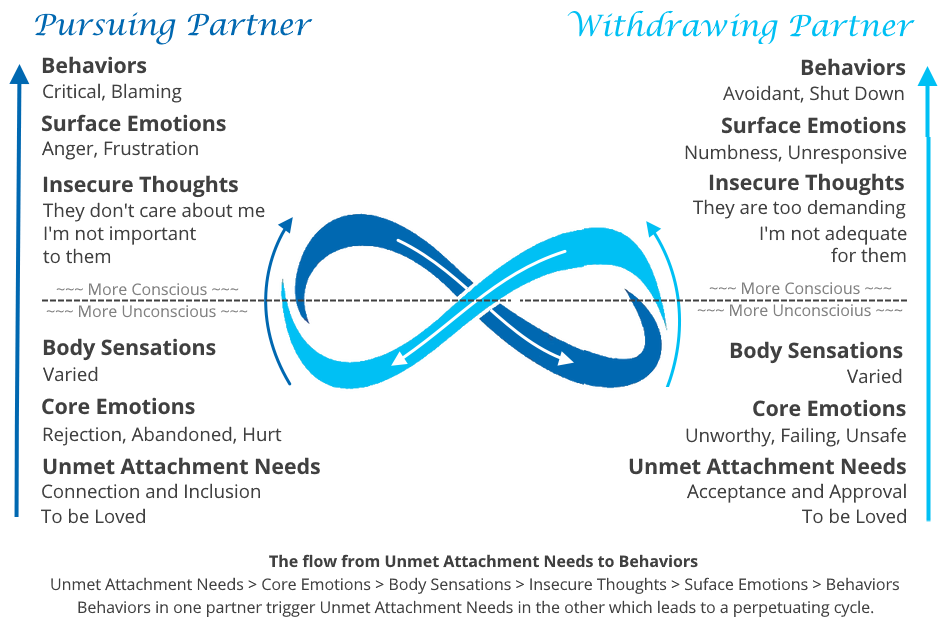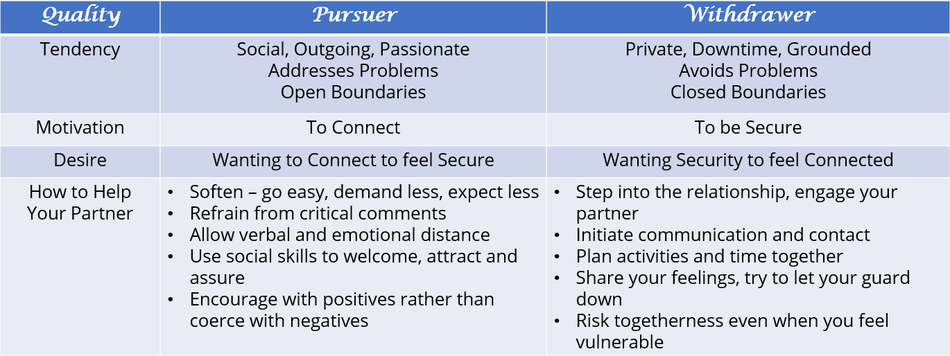Pursuer-Withdrawer Dynamic
Feeling emotionally secure and safe with your partner is foundational to a healthy, thriving relationship. However, conflict is unavoidable. The presence of conflict itself is not the problem. In fact, sometimes a total lack of conflict (or indifference) could indicate that one or both partners have given up hope - they feel resigned to an unfulfilling relationship. For many couples, we can argue and fight when we feel unimportant, unloved, or insecure with our partner. We are fighting because our relationship is important to us. What position do you adopt in an argument with your loved one? What is your attachment style? Are you a pursuer, or a withdrawer?
Free Attachment Style Assessment
Note: if you provide your email at the end of the assessment you will be sent a more detailed analysis
Pursuer
In a fight or argument, the pursuer protests to be heard or reached for connection by ‘moving towards’ their partner. They usually don’t let things lie or allow time to pass before bringing up a problem. They tend to be more emotional and intense, with a high sensitivity to lack of response or what seems like a rejection. This partner may react with disappointment, fear, or anxiety when their withdrawer partner is unresponsive. When distressed, they can become blaming and critical, telling their partners how to improve or change, making threats, getting pushy, prodding, and even blowing up in anger. If the pursuer is a woman, she may resort to nagging in an attempt to get her husband to open up and share feelings, so that she can feel emotionally connected and feel close to him. If the pursuer is a man, he may move towards his partner, wanting closer connection through touch, or sexual intimacy and if the partner is unresponsive, it can be interpreted as deep rejection causing feelings of unworthiness or shame. On the surface, the pursuer’s behavior may not seem to make sense because it does not endear them to their partner or solve the problem. However, the pursuer’s behavior is a desperate attempt to reconnect and feel safe again, because pursuers experience disconnection as distressing, painful, and fearful. Most of the time, the underlying reason is that remaining connected and secure in the relationship is simply THAT important. Over time, a pursuer may feel so fatigue that they experience burnt out. And in those times, this may misinform the withdrawing partner that things are getting better. But they really are not.
Meanwhile, the behavior of a withdrawer in a fight is to ‘move away’ from their partner by avoiding the conflict, minimizing the issue, deflecting, defending, shutting down, clamming up, or walking away. Withdrawers sometimes feel the need to move away to ‘protect’ or maintain the relationship. They also feel the need to protect themselves. Withdrawers tend to have difficulty identifying their feelings. However do not be fooled, withdrawers feel emotions just as intensely except they can't make sense of them as emotions flood them. They tend to feel overwhelmed so they shut down. When asked ‘How do you feel?’ withdrawers will often respond ‘I don’t know’, or offer a totally rational ‘thinking’ response that doesn’t match the emotional query of the pursuer partner. Withdrawers may seem to prefer downtime or their own company rather than intimate time with a partner. When conflict arises, a withdrawer tends to become silent and avoidant. If the withdrawer is a husband who is being nagged by a pursuer wife, he may feel pressured, overwhelmed or not good enough, subsequently he may react by shutting down and turning away. If the withdrawer is a wife and when pursued by the pursuer husband, she may experience feelings of intense anxiety and fear. She may also feel like she is failing as a wife. Feeling connected to their partners and secure in the relationship is equally as important for withdrawers but they need to know and feel emotionally safe first and foremost before they can comfortably connect and remain connected. If the pattern of pursuit continues from the pursuing partner, the withdrawing partner can feel so pressured, unsafe that it may take a while for them to feel safe enough to take a risk, to approach their pursuer partner again.
Withdrawer
The pursuer-withdrawer pattern can be found in either heterosexual or same-sex relationships, and these relational styles are not gender specific. Men and women can be either pursuers or withdrawers. Regardless of gender, pursuers and withdrawers are attracted to each other. About 80% of relationships follow this relational dynamic. The attraction between pursuers and withdrawers is understandable. Pursuers tend to initially find withdrawers calm, self-sufficient, even confident. Withdrawers, on the other hand, usually find pursuers to be passionate, confident, ambitious, and driven.
Every couple consciously or unconsciously devises a way of communication with each other, including how to manage conflict. When a pursuer and withdrawer enters a relationship, there is usually an initial period of happy togetherness, the so-called honeymoon period. However, it is at moments of stress, illness, or other significant conflict that the couple’s interactional dance of pursuer and withdrawer kicks in. These two relational patterns tend to ‘clash’.
The pursuer (who tends to react emotionally and immediately) wants to tackle the issue quickly and head on so she/he can feel secure again, while the withdrawer (who prefers to think about things at their own pace or to use compulsive behaviors to avoid emotions) finds the intensity overwhelming and shuts down, which is usually the withdrawers default position. The pursuer perceives the withdrawer’s retreat as inaction or may believe that their withdrawer partner has become disinterested. As the pursuer becomes more anxious, the intensity of the pursuit increases, which leads to the withdrawer feeling more overwhelmed and withdrawing further out of reach.
Pursuers feel unheard and unimportant, and withdrawers feel harassed and misunderstood. The pursuer may feel unloved, abandoned, or lonely, which leads them to amplify efforts to reconnect through affection, sex, intimate conversation, or quality time together; meanwhile, the withdrawer is feeling pressured, smothered or attacked, leading them to close down emotionally and attempt to disengage from interaction with the pursuer. In couples or marriage counseling, this pattern is referred to as a ‘negative cycle’.



